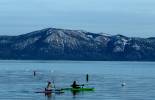The unknown draws us to hunting
The sun was just lighting the horizon when I pulled out of the driveway Monday morning. A quick glance at the truck’s thermometer let me know it was going to be on the warm side once the sun came up, not unusual for opening day of Nevada’s mourning dove season. What the thermometer couldn’t tell me was if doves would be flying when shooting time began. That secret remained unknown, at least for the time being.
Perhaps it is the unknown, at least in part, that draws us to hunting in the first place. Even when hunting a place we have hunted before, there always is the chance we will experience something new. During the 2013 deer season, I spent 10 days with my friends in central Nevada. They had deer tags. I was along for the ride.
One afternoon it was raining fairly hard so we opted to drive to Ely for lunch and to buy a few supplies. On our way back to camp we decided to explore some areas we had never seen before. We turned down a side road that led into a series of draws carpeted with sagebrush and bitterbrush, and lined with pinion pines and juniper trees.
Along the way we found a series of rock formations that on another day would have enticed us to go exploring, we saw a few bull elk and heard them screaming challenges to one another as they pushed their harems deeper into the trees, and we found some good looking country that had mule deer written all over it. Last year that area was an unknown. This year it isn’t, and I just happen to have a deer tag of my own this time around.
No matter which species we are pursuing — if we follow the principles of fair chase — the outcome is always in doubt. Even when it seems like everything is going your way and that you will finally close the gap on your quarry, something as subtle as a wind shift can significantly alter your luck. Anyone who has spent time hunting big game can attest to that.
It was almost legal shooting time when I stopped the truck near the stand of trees I hunt when time is limited. It isn’t very far from home, but that means it can be a little crowded on opening day. And Monday was no different.
Leaving the truck behind, I shouldered my 870 Wingmaster and started walking. The old pump felt familiar in my hands. After more than 30 seasons in the field, the bluing is worn thin in several places and there is a divot in the stock where the gun took the blow from a falling rock so my head didn’t. I can’t tell you how many shells have passed through its action, but the gun still does what it was meant to do. And when it comes to my shoulder, it just feels like it belongs there.
Suddenly, the unmistakable thunder of shotguns sounded in the distance. The dove season was officially underway. I found a shady spot sandwiched between to large creosote bushes and settled in to wait for the morning flight of doves heading in to water at some nearby ponds. After a time, another round of shots sounded in the distance. I scanned the horizon but saw nothing.
As I waited the sun climbed, the temperature warmed and the hunters who had gathered continued to wait. Then someone on the far side of the trees fired, and I could hear another hunter giving him directions to the downed bird. Meanwhile, I continued to wait and scan the horizon. Nothing.
Mourning doves have a distinctive look and their acrobatic flying pattern makes them easy to identify on the wing, but it also makes them a difficult quarry. While there were a few shots in the distance, there were only a handful taken by any of the hunters hidden among the trees and brush nearby. As for me, I saw nary a bird.
When it became apparent that there would be no morning flight, and that opening day 2014 would go down in the history books as one of the slow ones, I shouldered the old shotgun and headed back to the truck. While there were no birds to clean and put on ice, I did get to experience yet another opening day sunrise and the feelings that come with it. The events of opening day were no longer unknown, but what the remainder of dove season holds for us still is. I guess we will just have to go afield another day so we can find out.
Freelance writer Doug Nielsen is a conservation educator for the Nevada Department of Wildlife. His “In the Outdoors” column, published Thursday in the Las Vegas Review-Journal, is not affiliated with or endorsed by the NDOW. Any opinions he states in his column are his own. He can be reached at intheoutdoorslv@gmail.com.























